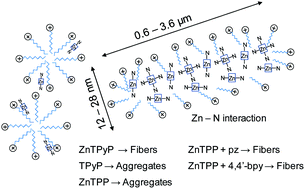論文がアクセプトされました(山崎先生・村藤先生 共著)
The Formation Mechanism of ZnTPyP Fibers Fabricated by A Surfactant-Assisted
Method
K. Tashiro,T. Murafuji, M. Sumimoto, M. Fujitsuka, S. Yamazaki
New J. Chem., 2020, 44, 13824-13833.
DOI: 10.1039/D0NJ02829K
Abstract: Fibers composed of 5,10,15,20-tetrakis(4-pyridyl)porphyrinatozinc(II)
(ZnTPyP) were synthesized by a surfactant-assisted method using cetyltrimethylammonium
bromide (CTAB) and chloroform. The presence of CTAB was essential to make
and to maintain the fibers and their formation rate became slower with
increasing the molar ratio of CTAB to ZnTPyP. Measurements of absorption
spectra of the synthesized fibers showed splitting of the Soret band at
426 nm into two peaks at 416 and 454 nm in accordance with the formation
of the ZnTPyP fibers as revealed by transmission electron microscopy. The
aging process at higher temperature made the fibers longer and the apparent
activation energy for the formation of the fibers was estimated to be 74.8
kJ mol−1. When 5,10,15,20-tetrakis(4-pyridyl)porphyrin (TPyP) or 5,10,15,20-tetrakis(phenyl)porphyrinatozinc(II)
(ZnTPP) was used instead of ZnTPyP, no fiber formation was observed. On
the other hand, when a chloroform solution of ZnTPP was mixed with pyrazine
or 4,4′-bipyridine, the fiber formation was observed. Proton nuclear magnetic
resonance spectra indicated upfield shifts of the pyridinic proton in the
presence of ZnTPP and 4,4′-bipyridine, suggesting the coordination of nitrogen
to zinc(II) (Zn–N) in ZnTPP. These findings indicate that the Zn–N coordination
is crucial for the formation of the fibers and that nitrogen in the pyridyl
moiety of ZnTPyP is coordinated to the central zinc(II) ion of another
ZnTPyP molecule to make the ZnTPyP fibers. Theoretical calculations were
performed using the DFT/B97D functional to estimate the stability of the
π–π stacking and the coordination of Zn–N. The presence of the CTAB micelles
suppresses the aggregation of ZnTPyP molecules due to the π–π stacking,
which is thermodynamically more favorable. The Zn–N coordination proceeds
moderately during the aging process for 10 days by inducing the transition
from spherical CTAB micelles to rod-like micelles by fusion.
